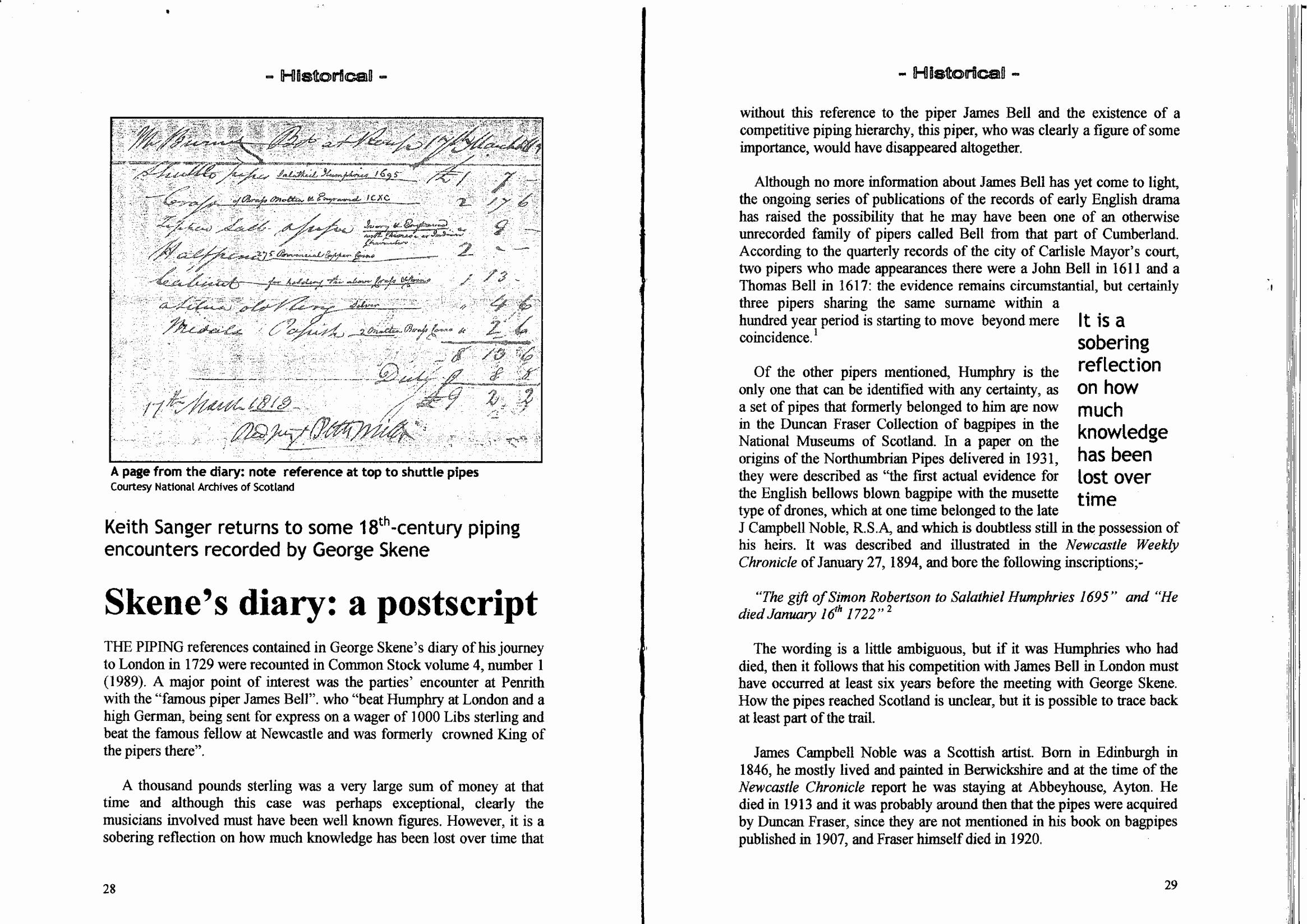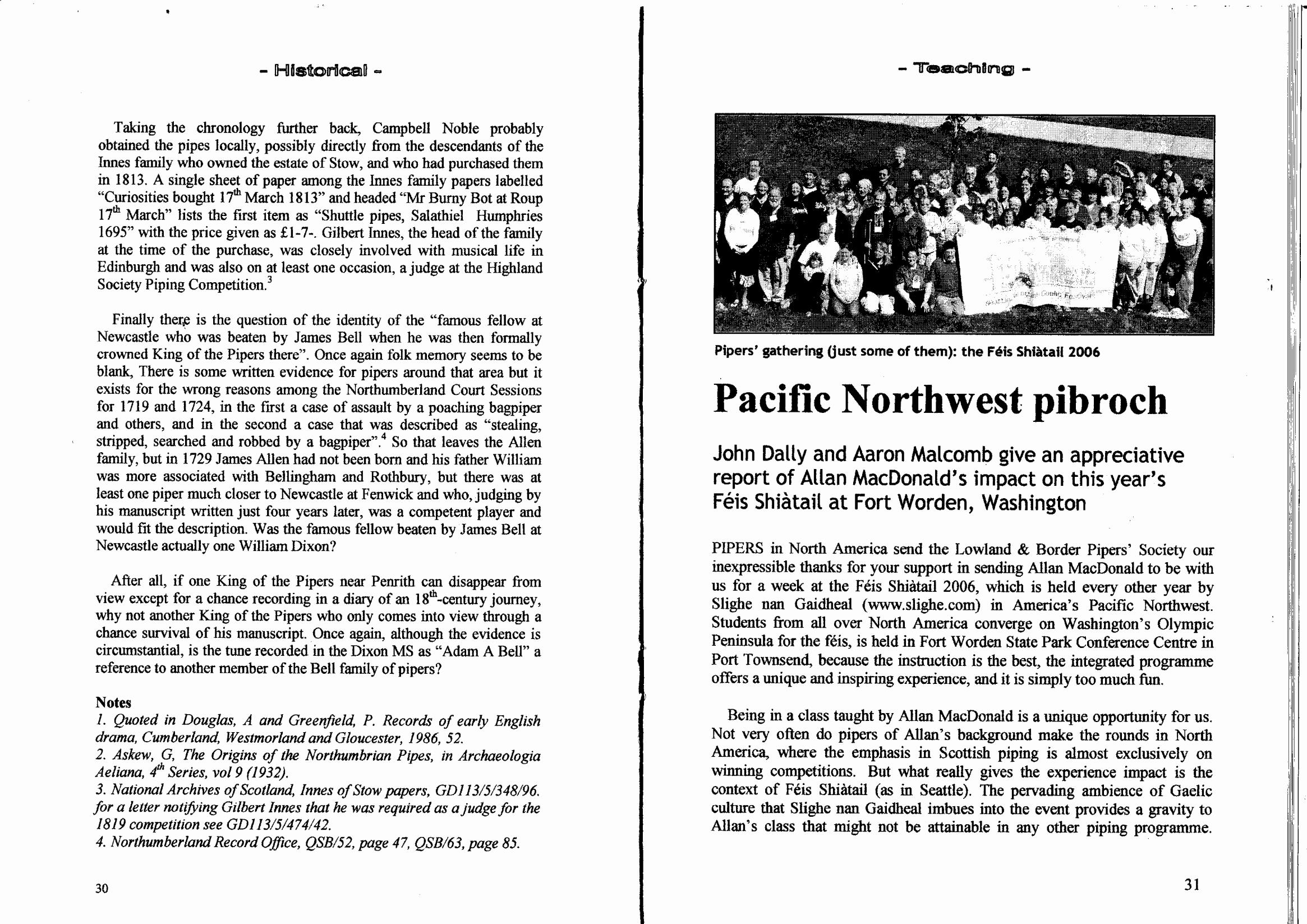Skene's Diary


Keith Sanger returns to some 18th-century piping encounters recorded by George Skene
Skene’s diary: a postscript
THE PIPING references contained in George Skene’s diary of his journey to London in 1729 were recounted in Common Stock volume 4, number 1 (1989). A major point of inter- est was the parties’ encounter at Penrith with the “famous piper James Bell”, who “beat Humphry at London and a high German, being sent for express on a wager of 1000 Libs sterling and beat the famous fellow at Newcastle and was formerly crowned King of the pipers there”.
A thousand pounds sterling was a very large sum of money at that time and although this case was perhaps exceptional, clearly the musicians involved must have been well known figures. However, it is a sobering reflection on how much knowledge has been lost over
time that without this reference to the piper James Bell and the existence of a competitive piping hierarchy, this piper, who was clearly a figure of some importance, would have disappeared altogether.
Although no more information about James Bell has yet come to light, the ongoing series of publications of the records of early English drama has raised the possibility that he may have been one of an otherwise unrecorded family of pipers called Bell from that part of Cumberland. According to the quarterly records of the city of Carlisle Mayor’s court, two pipers who made appearances there were a John Bell in 1611 and a Thomas Bell in 1617: the evidence remains circumstantial, but certainly three pipers sharing the same surname within a hundred year period is starting to move beyond mere coincidence.1
Of the other pipers mentioned, Humphry is the only one that can be identified with any certainty, as a set of pipes that formerly belonged to him are now in the Duncan Fraser Collection of bagpipes in the National Museums of Scotland. In a paper on the origins of the Northumbrian Pipes delivered in 1931, they were described as “the first actual evidence for the English bellows blown bagpipe with the musette type of drones, which at one time belonged to the late J Campbell Noble, R.S.A, and which is doubt- less still in the possession of his heirs. It was described and illustrated in the Newcastle Weekly Chronicle of January 27,1894, and bore the following inscriptions;-
It is a sobering reflection on how much knowledge has been lost over time
“The gift of Simon Robertson to Salathiel Humphries 1695” and “He died January 16th 1722”2
The wording is a little ambiguous, but if it was Humphries who had died, then it follows that his competition with James Bell in London must have occurred at least six years before the meeting with George Skene. How the pipes reached Scotland is unclear, but it is possi- ble to trace back at least part of the trail.
James Campbell Noble was a Scottish artist. Born in Edinburgh in 1846, he mostly lived and painted in Berwickshire and at the time of the Newcastle Chronicle report he was stay- ing at Abbeyhouse, Ayton. He died in 1913 and it was probably around then that the pipes were acquired by Duncan Fraser, since they are not mentioned in his book on bagpipes pub- lished in 1907, and Fraser himself died in 1920.
Taking the chronology further back, Campbell Noble probably obtained the pipes locally, possibly directly from the descendants of the Innes family who owned the estate of Stow, and who had purchased them in 1813. A single sheet of paper among the Innes family papers labelled “Curiosities bought 17th March 1813” and headed “Mr Burny Bot at Roup 17th March” lists the first item as “Shuttle pipes, Salathiel Humphries 1695” with the price given as £1-7-.
Gilbert Innes, the head of the family at the time of the purchase, was closely involved with musical life in Edinburgh and was also on at least one occasion, a judge at the Highland Society Piping Competition.3
Finally there is the question of the identity of the “famous fellow at Newcastle who was beaten by James Bell when he was then formally crowned King of the Pipers there”. Once again folk memory seems to be blank, There is some written evidence for pipers around that area but it exists for the wrong reasons among the Northumberland Court Sessions for 1719 and 1724, in the first a case of assault by a poaching bagpiper and others, and in the second a case that was described as “stealing, stripped, searched and robbed by a bagpiper”4 So that leaves the Allen family, but in 1729 James Allen had not been born and his father William was more associated with Bellingham and Rothbury, but there was at least one piper much closer to Newcastle at Fenwick and who, judging by his manuscript written just four years later, was a competent player and would fit the description. Was the famous fellow beaten by James Bell at Newcastle actually one William Dixon?
After all, if one King of the Pipers near Penrith can disappear from view except for a chance recording in a diary of an 18th-century journey, why not another King of the Pipers who only comes into view through a chance survival of his manuscript. Once again, although the evidence is circumstantial, is the tune recorded in the Dixon MS as “Adam A Bell” a reference to another member of the Bell family of pipers?
Notes
- Quoted in Douglas, A and Greenfield, P. Records of early English drama, Cumberland, Westmorland and Gloucester, 1986,
- Askew, G, The Origins of the Northumbrian Pipes, in Archaeologia Aeliana, 4th Series, vol 9 (1932).
- National Archives of Scotland, Innes of Stow papers, GDI13/5/348/96. for a letter notify- ing Gilbert Innes that he was required as a judge for the 1819 competition see GDI13/5/474/42.
- Northumberland Record Office, QSB/52, page 47, QSB/63, page 85
